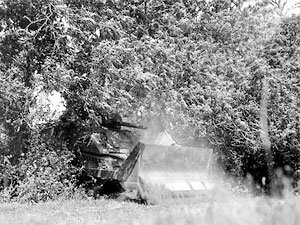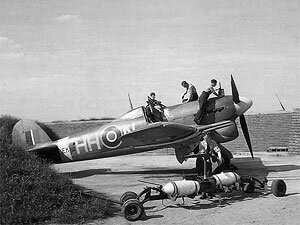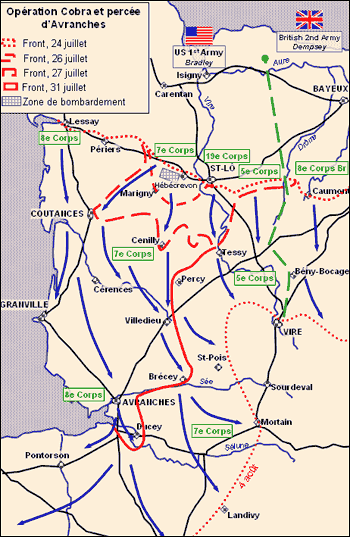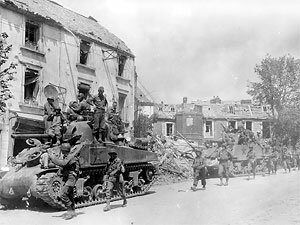The battle
Cobra - the American breakthrough
General situation on the Normandy front
 Sherman “dozer” in the bocage. Bocage countryside, particularly
Sherman “dozer” in the bocage. Bocage countryside, particularly
intense in the American sector, offered to the Germans ideal defen-
sive conditions. © CR Basse Normandie - National Archives USA By late July 1944, after six weeks of fighting since their landings in Normandy, the progression of allied forces had been remarkable, but seemed in no way to threaten the German defenses.
- On the eastern flank of allied bridgehead, after operation Goodwood, the 2nd British Army (gen. Dempsey) had just captured the southern bank of the Orne River, in Caen; the British were now trying, without much success, to advance on the wide plain opening towards Falaise;
- To the west, the 1st US Army (Bradley) had been involved for three weeks in nightmare-like fighting on the way to Saint-Lô. During the attack, the Army exhausted the best of its divisions earning only limited territorial profits.
Admittedly, the American forces had liberated entire Cotentin peninsula and took Cherbourg, but their advancement southward was strongly handicapped by terrible Norman hedgerows (called “bocage”) and by well-prepared German defenses. The soldiers called it accordingly the “hedgerows war”.
In spite of the mixed results, the position of power had been irrevocably turning in favour of the Allies.
 Typhoon fighter-bomber. Its support to infantry and allied armour
Typhoon fighter-bomber. Its support to infantry and allied armour
was decisive throughout the countryside of Normandy, allowing to
overcome the technical superiority of German tanks.
With respect to the level of involved forces, more than one million allied soldiers had landed in Normandy in July, for only a few tens of thousands of German armed forces. The allied soldiers were not only more numerous, but also their experience and their motivation have increased.
On contrast, the Germans suffered from their weak reserves; skilled veterans were only a handful, and the bulk of the troop constituted of young and inexperienced recruits. The fanaticism of SS divisions, such as 1st Leibstandarte SS Adolf Hitler, 2nd Das Reich, or 12th Hitlerjugend helped, in part, to overcome these shortages, but all these divisions were becoming more and more an isolated elite.
On the other side, one could find a large number of so-called “static divisions”, composed of poorly trained recruits, Osttruppen battalions (mainly Russian prisoners), which were commanded by low-morale officers and operating obsolete equipment. The use of these units was highly inadequate for modern warfare and also illustrated the extreme destitution of Wehrmacht. What can one expect as combative value from Alsatians, Lorrains, or Silesians, forced into the army, and who will massively desert at the time of the engagements?
Regarding level of the equipment, as of July 20, 1944, 350.000 vehicles, 1,5 million tons of ammunition and all types of other equipment had arrived through artificial harbours as well as through the port of Cherbourg, which was then operational. The Allies received several thousands of new tanks, while the German replacements were limited to tens of units.
Admittedly, the 503. s. Pz. Abt. just arrived with its 45 King Tigers, models that could not by defeated by any allied tank, but this would be similar to an attempt to extinguish a large fire with a glass of water: Germans 150 tanks and 9 divisions were no match for 750 tanks and 15 divisions deployed by general Bradley.
In reference to tactics, the allied soldiers very quickly managed to learn how to adapt their conduct to the situation on the battlefield:
- In order to face the hedgerows, tankers equipped their Sherman tanks with steel jaws gaining capability to pass through the hedges while avoiding exposing their weakly armoured lower sides to German AT devices;
- To face the qualitative superiority of the German tanks, allied forces developed, to unprecedented scale, cooperation between troops and aviation. This support was carried by P47 Thunderbolt or Typhoon fighter-bombers for close-support, as well as heavy bombers for “Carpet Bombings”. At the highest point of fighting, Luftwaffe fought at the ratio of one to ten;
- Eventually, in order to overcome enemy mobility, the Allies mechanized their army to the point of completely eliminating horses, while traditional German infantry units continued using them for transportation.
From the point on, the Allies imposed the rate of the combat. Operation Cobra will later demonstrate what they learned during the preceding weeks.
Operation Cobra
After the failure of “hedgerows war”, General Bradley started preparing a large-scale operation, which would be an extension of earlier action on Saint-Lô. This time he aimed at the point located between the rivers Vire and Lozon, which was held by the experienced 7th Corps (Collins).
Upcoming operation was impressive and ambitious. Bradley requested a massive bombardment in order to strike a restricted perimeter and eliminate any existing German defenses in this sector. Then, the infantry’s goal was to get rid of the few remaining survivors and secure the perimeter of a corridor, into which a massive tank assault would push towards Coutances, and if possible, Avranches. In the meantime, a general attack of other army Corps would prevent the Germans from organizing a counter attack.

 In Coutances, a column of GI's advances supported by a Sherman
In Coutances, a column of GI's advances supported by a Sherman
tank. Coordination between infantry, tanks and air support was
the key to the success of Cobra. © CR Basse-Normandie – National
Archives USA
An original planned date for operation Cobra was delayed due to poor weather conditions. The operation was finally launched the following day, July 25th, around 11 AM. An area the size of 7 x 3 km located between La Chapelle-Enjuger and Hébécrevon was pounded for 3 hours by as many as 1.900 heavy, and 600 medium bombers, which dropped more than 4.000 tons of bombs.
Although some bombs did fall on US positions, this action created a hell-like situation for the Germans; the 40-ton tanks were turned over like toys and infantrymen were buried alive in their shelters. The elite Panzer Lehr Division known for giving a hard time to the GI’s during previous operations, was rendered completely ineffective by the bombing and virtually ceased to exist. Other units suffered similar damages and casualties.
After the bombardment has ceased, American infantry spent the afternoon of July 25th fighting in the rumbles. The 9th and 30th infantry divisions, which lead the attack, carried out a difficult fight against ferocious remnants of now agonyzing Panzer Lehr. Nevertheless, Bradley was right: German forces, which had not suffered from the bombardment, were at best able to hold the ground, but certainly were not able to organize any counter-attack. In the morning of July 26th, it was clear that German positions started to crumble. Bradley took advantage of the situation and made a risky decision ordering his reserve armoured divisions and 8th Corps to enter the fighting.
General Middleton released immediately his 8th Corps to the attack, thus preventing the Germans from transferring troops eastward, into the endangered sector. More east, the 2nd and 3rd armored divisions replaced infantry divisions as leading force, and entered deeply behind German lines. In the evening, having lost no more than a handful of its tanks, the 2nd armored division had advanced 10 kilometers. The city of Canisy was liberated the same day.
On July 27th, the American troops have advanced 25 km southward. In the pocket of Roncey the 2nd and 3rd armored divisions were progressively trapping overwhelmed German units which were already facing the attack of the 8th Corps on the west side of the main assault. On July 29th, Middleton managed to seize an important crossroad, Coutances, thus preventing German commander Dietrich Von Choltitz from rebuilding a front line from the remains of his 84th Corps. In the meantime, German elite 2nd SS-PzD “Das Reich” had been encircled in the pocket of Roncey, and took the erroneous decision to try to break east, through american lines, instead of escaping to the south. In the result, many of its kampfgruppen were destroyed in the neighbourhood of Notre-Dame de Cenilly and St-Denis du Gast during the night.

Americans were continuously leading southward and on July 30th, they seized Avranches and continued advancing farther. The next day, by catching the bridge of Pontaubault the American troops opened the door of Brittany. From this point on, they could easily circumvent the Germans, whose access to the ocean had been cut off. The so long awaited breakthrough had been finally carried out!













 www.evl.pl
www.evl.pl